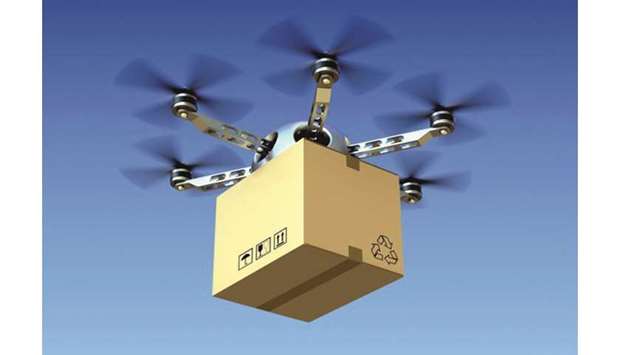Imagine you’re standing in your front yard when a drone flies overhead, delivering a package to one of your neighbours.
The drone goes over your house, flying much lower than a helicopter could. Would that be considered trespassing? After all, you didn’t even order the package. What if the drone took pictures of you and everything else in your yard as it went by; is that allowed? What if it malfunctioned and fell on your head — who would be at fault?
These are some of the thorny legal questions that will have to be answered as companies such as Google parent Alphabet Inc, Amazon.com Inc and UPS Inc start preparing for a future where delivery by drone is more widespread.
Last week, Alphabet subsidiary Wing became the first company to operate a commercial drone delivery service in the United States: It ferried tissues, bottled water, cough drops and other products to people in Christiansburg, Virginia. Christiansburg is small — it has only about 21,000 residents — and Wing’s delivery service is only for the last mile of a package’s journey, but there are plans for more coverage in the future.
Wing isn’t the only company interested. This month, UPS got permission from the Federal Aviation Administration to operate delivery drones at university, hospital and corporate campuses. Amazon, meanwhile, has long been working on its own robotic delivery service, and this summer it unveiled a new drone that it said was optimised for courier work.
But technology is only part of the puzzle. There are still questions about how drone delivery systems will navigate privacy and trespassing issues and concerns about noise.
“Legal precedent is very thin here,” said Arthur Holland Michel, co-director of the Center for the Study of the Drone at Bard College. “Little of the existing law is based specifically on drones.”
It’s also unclear who will be the ultimate arbitrator for these concerns. The FAA is in charge of aircraft safety, but questions of privacy or trespassing could be left up to the states, said William Breetz, vice president of the Uniform Laws Commission, a nonprofit organisation that drafts model legislation for states and began tackling drone laws more than two years ago.
Here’s more information about some of these undetermined issues.
Do you own part of the airspace above your house or can a drone fly freely through?
When it comes to drone delivery services, questions about potential trespassing still remain.
Some property owners have argued that they own a certain amount of the airspace above their homes, meaning any drones that fly into that area without permission would be unwanted visitors.
Others have said you don’t own that when it comes to aircraft. Drones are categorised as aircraft, and the FAA has stipulated that no-one has the right to interfere with the flight of an aircraft.
“There’s a lot of uncertainty now in the law for those kinds of issues,” said Robert Heverly, associate professor of law at Albany Law School.
Others have expressed concerns about what kinds of data delivery drones could gather on their flights to and from drop-off points. Amazon has a patent for a data analysis system that would use information the drone collected during its flight to help make recommendations for future purchases. For example, if the drone took an image of your dead lawn while it was delivering your package, perhaps you’d get more online ads for fertiliser.
While many local governments forbid the use of drones for surveillance purposes, it’s unclear whether the activities described in Amazon’s data analysis patent would fall under that definition, Holland Michel said.
Current privacy standards were established long before the advent of drones, let alone potential drone delivery operations, he said.
“There are questions around whether these standards need to be updated in light of the fact that we are looking at a near-future where the airspace will be very crowded with drones that are all capturing information,” Holland Michel said.
If a drone has a glitch and drops its package on you, leaving you injured, who’s at fault?
In some cases, existing laws could apply. For example, if a delivery drone dropped a package that hit someone, the drone operator and his or her employer would most likely be liable — in line with standard rules on negligence, Heverly said.
The same would likely apply to a drone that damaged property in the course of a delivery, Heverly said.
But it could get tricky if delivery companies employ subcontractors to operate the drones.
In those cases, the companies could defer responsibility to the contracted operator if something happened, though it depends on how much control the companies have over the individual subcontractors, Heverly said. The more rules and restrictions the company has for its subcontractors, the more the company could be considered the employer, meaning it would take on the liability.
For the person who was hit by the drone, their lawyer would likely sue both parties — the drone operator and the company that hired that operator — and sort out the responsible party through litigation, Heverly said.
How loud is too loud for a drone buzzing through the air?
In April, Wing launched its first air delivery service in Canberra, Australia, but not all of the residents were happy with it. People complained that the drones were too noisy.
The Australian government later found that the decibel level from about 50 feet away was similar to a loud television and exceeded the daytime noise standard for the residential area. Wing developed a quieter propeller and promised other improvements, the Australian Broadcasting Corp. reported. It’s still operating in Canberra.
Small drones can be significantly quieter than larger, professional-quality ones, though the sound from all drones are typically less noticeable the higher they fly, Heverly said. In the United States, he said, regulating drone noise will probably be up to local governments. — Los Angeles Times/TNS

..


